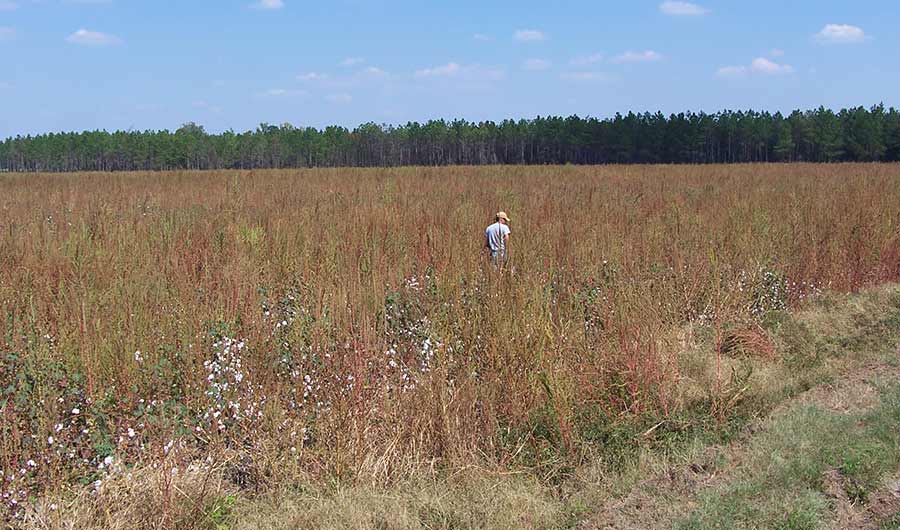Climate Change May Worsen Spread of Invasive Superweed

Courtesy of Stanley Culpepper
This image may be reproduced only with this Inside Science article.
(Inside Science) -- It's the worst weed in the whole country, according to the Weed Society of America. Palmer amaranth can grow to be 10 feet tall and as thick as a baseball bat. The weed has evolved resistance to multiple classes of herbicides, and it thrives in fields of corn, soybeans and cotton. Invaded cornfields can face losses of up to 91 percent.
"It's a beast," said Erica Kistner-Thomas, an ecologist with the U.S. Department of Agriculture's Agricultural Research Service in Ames, Iowa. "It will take over the field and take all the resources -- the nitrogen and the water -- away from the crops."
With tiny seeds that often hitch rides on farm equipment, the weed has already spread from its native Southwest desert into most of the continental U.S., and has established populations in Egypt, Israel, Turkey, Greece, Spain, Argentina and Brazil. A new study suggests that it will keep spreading across much of the globe.
Kistner-Thomas and her colleagues used software called CLIMEX to predict where palmer amaranth would be able to survive, based on its favored growing conditions for temperature and rainfall. According to the model, most of sub-Saharan Africa, India and Australia are ripe for invasion.
Under current climate conditions, the weed has trouble surviving in central Europe and the northern U.S., while northern Europe and Canada are mostly safe because they get too cold in winter. Indeed, palmer amaranth has been found repeatedly in colder countries such as Germany, Norway and the United Kingdom, but has so far failed to establish populations there.
That could change if the world keeps warming. Under the most extreme or "business as usual" greenhouse gas emissions scenario, the amount of land with a suitable climate for palmer amaranth in the U.S. would increase by 21 percent by the year 2050, opening up an additional 17,267 square miles to invasion. In Canada, the amount of climatically suitable habitat would increase more than tenfold, from about 1,240 square miles to 13,795 square miles, according to the model. Kistner-Thomas published the findings earlier this year in the journal Agricultural & Environmental Letters, and presented them this summer at the Ecological Society of America meeting in New Orleans.
"Climate change is going to benefit this heat-tolerant weed," said Kistner-Thomas. And, she added, "once it gets established, you're not going to get rid of it."
Some people may wonder why farmers are so eager to get rid of palmer amaranth, given that amaranth has been cultivated as a food crop for thousands of years and is now sold as a specialty item in American grocery stores. But while indigenous people in the Sonoran desert once gathered palmer amaranth for food, the types of amaranth that are grown as grains and vegetables today are not the same as palmer amaranth and related weeds. The modern cultivated species are highly nutritious and palatable, tasting somewhat like refined wheat flour, according to Jaime Amaya-Farfan, a food and nutrition scientist at the University of Campinas in Sao Paulo, Brazil.
Wild amaranth species are still sometimes crossbred with domestic amaranth or used as animal feed, according to José Arêas, a food biochemist in the Department of Nutrition at the University of Sao Paulo in Brazil. But in general, said Arêas, wild amaranth species are viewed as pests. Stanley Culpepper, a weed scientist at the University of Georgia in Tifton, has tried eating palmer amaranth, and called the taste "horrible."
Even if it were valuable as a crop, said Culpepper, palmer amaranth's competitive vigor could be more a curse to farmers than a blessing. Crop rotation is essential for controlling pests and replenishing soil, but once a field had been used to grow palmer amaranth, it would be hard to grow anything else there because of the seeds left in the soil.
"There's no way you can get them all. You're going to spill some," said Culpepper. "It would be a tremendous challenge, and could potentially be a nightmare."
So what's to be done about the weedy invader? Kistner-Thomas doubts it will be possible to completely prevent palmer amaranth from spreading, but there are ways to control it on farms. For example, the seeds don't sprout unless they are exposed to sunlight, so farmers can till the soil to bury seeds or plant a cover crop to shade them, said Culpepper. It's essential to act quickly, he said, and to use a combination of methods, since one approach won't be enough.
Such efforts are costly. Ignoring inflation, Georgia cotton farmers spend about twice as much battling weeds today as they did in 2001, with the increase due to herbicide-resistant palmer amaranth, said Culpepper. But the efforts have worked to save Georgia's crops, and Culpepper expects they could work in other places, too.
"When we started dealing with this plant, especially when it came to resistance, there was no research, there was no data, there was no information. There was no help," said Culpepper. "No one would be walking into the same scenario we did, because there's so much data currently available."

